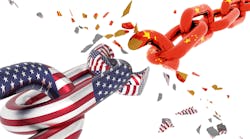Apple and Huawei Technologies announced their latest high-end smartphones last month with the usual fanfare. But something that had nothing to do with screen sizes or camera megapixels loomed over the launches: the decoupling of the U.S. and Chinese economies.
Escalating tensions between the U.S. and China have accelerated the unraveling of globalization more quickly than many predicted even a year ago. The Covid-19 pandemic, the anti-China sentiment that followed, and the increasingly tense political climate have raised the stakes. Now, it’s clear the world isn’t going back to globalization—it’s headed toward decoupling.
China-based Huawei is caught in the middle of the intensifying geopolitical conflict between its home country and the U.S. A global leader in telecommunications network equipment and smartphones, Huawei has been hampered by President Donald Trump’s executive order forbidding U.S. companies from working with the company or buying its products.
Some analysts believe Huawei’s business challenges could benefit rival Apple. The U.S.-based company’s latest iPhone will have 5G network capabilities, a bid to grow Apple’s share of the Chinese market, where 5G technology is more prevalent than in the U.S. China is a key market for Apple, and the company is increasingly contending with local competitors that might further gain the hearts of Chinese customers as U.S.-China geopolitical tensions rise. Apple executives can’t ignore those tensions. Indeed, last year the company was reportedly looking into the possibility of moving one-third of its production for some devices out of China.
Decoupling would create two walled gardens in global trade: a China-allied trading bloc and supply chain, and a U.S.-allied one. That has big implications for all businesses, but technology manufacturers would be among those most affected. The mutual dependency between the U.S. and Chinese technology sectors has been a critical factor in the way the industry has evolved, especially over the past decade. The decoupling will also be a watershed.
Already, the political maneuvering and growing momentum toward decoupling are pushing technology executives in China, the U.S. and around the world to reevaluate their global strategies. Here are the critical moves to watch for as companies try to balance the desire to sell into both the U.S. and China blocs, protect their intellectual property and outgrow competitors.
U.S. companies trying to sustain business in China. Companies are increasingly likely to map out a multiyear strategy for developing products geared toward the Chinese market, based on the company’s competitive advantage over local alternatives, and what’s considered “good enough” in the target segment. One option is to partner with a local business in China to gain access to the market with a mandate requiring purchases from indigenous companies. For example, Hewlett-Packard Enterprise has a successful partnership with H3C that opens up the Chinese enterprise IT market for HPE.
In addition, U.S. companies might look to acquire assets or build new business models in segments where China or the Eastern Bloc has a strength that the U.S. lacks, such as 5G equipment.
Another key decision: Many companies are considering a “China-plus-one” supply chain model to reduce dependence on Chinese suppliers, add redundancy and increase resilience.
Chinese companies looking to expand globally. Leading companies tend to focus first on maximizing growth in the home market so they have a solid business foundation to withstand global headwinds. Once ready to invest outside of China, companies often emphasize geographic diversification to help mitigate geopolitical risks. They also build partnerships through equity investments and other types of deals, and establish regional entities and operations.
For example, Alibaba in 2018 doubled its investment in Southeast Asian online shopping giant Lazada to $4 billion. And Chinese smartphone brands such as Oppo, Vivo and Xiaomi have expanded their operations in European and Latin American markets in the past three years.
The last piece of this puzzle for many companies? Preparing a contingency exit strategy.
Companies headquartered everywhere else. In the short term, U.S.-China tensions might not hamper many of these companies. They might find open doors in both China and the U.S. But the march toward decoupling will affect every company in the long run. Some businesses based outside the U.S. and China have started laying the groundwork for localization in both blocs by making adjustments now across their supply chain, products, customer base and organization.
Compared with their U.S. and Chinese counterparts, this group has more degrees of freedom. But their choices also come with more uncertainty at this point.
Ultimately, the right answer to navigating this new world depends on the company and its industry, and must be graded against what the U.S. and Chinese governments are likely to allow. The complexities are high, but the prize is continued access to a large, global technology market.
Anne Hoecker and Shu Li are Bain & Company partners, and Jue Wang is a Bain associate partner. Hoecker leads the firm’s Technology practice in the Americas and is based in Silicon Valley. Li co-leads the firm’s Technology practice in Greater China and is based in Hong Kong. Wang is based in Silicon Valley.




